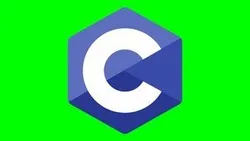
C Programming: Advanced Data Types - 5 
In this course, you will learn how to define your own data types in C, allowing you to store and process complex data more efficiently. You will also gain experience with programming concepts that are foundational to any programming language. C is widely used in embedded systems, robotics, and IoT, and is ranked third of the top programming languages of 2021 in demand by employers. At the end of this course, you will reach the fifth milestone of the C Programming with Linux Specialization, unlocking the door to a career in computer engineering. ▼
ADVERTISEMENT
Course Feature
![]() Cost:
Cost:
Free
![]() Provider:
Provider:
Coursera
![]() Certificate:
Certificate:
Paid Certification
![]() Language:
Language:
English
![]() Start Date:
Start Date:
29th May, 2023
Course Overview
❗The content presented here is sourced directly from Coursera platform. For comprehensive course details, including enrollment information, simply click on the 'Go to class' link on our website.
Updated in [April 24th, 2023]
This course, C Programming: Advanced Data Types - 5, provides an introduction to defining and using custom data types in C. Students will learn how to create their own data types to more efficiently store and process data, as well as gain foundational knowledge of programming concepts. At the end of the course, students will have reached the fifth milestone of the C Programming with Linux Specialization, unlocking the door to a career in computer engineering. This course is supported by the Patrick & Lina Drahi Foundation and is in line with IEEE's 2021 ranking of C as the third most in-demand programming language by employers.
[Applications]
Upon completion of this course, students will be able to apply their knowledge of advanced data types in C to a variety of programming contexts. They will be able to create their own data types to more efficiently store and process data, and will be well-prepared to pursue a career in computer engineering. Additionally, they will be able to apply their knowledge to embedded systems, robotics, and the Internet of Things (IoT).
[Career Paths]
Recommended Career Paths:
1. Programmer: Programmers use C to create software applications and systems. They are responsible for writing, testing, and maintaining code, as well as debugging and troubleshooting any issues that arise. With the increasing demand for software applications, the demand for programmers is also increasing.
2. Embedded Systems Engineer: Embedded systems engineers use C to develop and maintain embedded systems, such as those used in transportation, utility networks, and aerospace. They are responsible for designing, testing, and troubleshooting these systems. As the demand for embedded systems increases, so does the demand for embedded systems engineers.
3. Robotics Engineer: Robotics engineers use C to develop and maintain robots and robotic systems. They are responsible for designing, testing, and troubleshooting these systems. With the increasing demand for robots and robotic systems, the demand for robotics engineers is also increasing.
4. IoT Engineer: IoT engineers use C to develop and maintain Internet of Things (IoT) systems, such as those used in smart homes, automation, and wearables. They are responsible for designing, testing, and troubleshooting these systems. As the demand for IoT systems increases, so does the demand for IoT engineers.
[Education Paths]
The recommended degree paths for learners of this course are:
1. Bachelor of Science in Computer Science: This degree program provides students with a comprehensive understanding of computer science fundamentals, such as programming languages, algorithms, data structures, operating systems, and computer architecture. It also covers topics such as artificial intelligence, machine learning, and software engineering. This degree is becoming increasingly popular as the demand for computer science professionals continues to grow.
2. Master of Science in Computer Science: This degree program provides students with an advanced understanding of computer science topics, such as computer networks, distributed systems, and computer security. It also covers topics such as artificial intelligence, machine learning, and software engineering. This degree is becoming increasingly popular as the demand for computer science professionals continues to grow.
3. Master of Science in Data Science: This degree program provides students with an advanced understanding of data science topics, such as data mining, machine learning, and data visualization. It also covers topics such as artificial intelligence, natural language processing, and predictive analytics. This degree is becoming increasingly popular as the demand for data science professionals continues to grow.
4. Doctor of Philosophy in Computer Science: This degree program provides students with an in-depth understanding of computer science topics, such as computer networks, distributed systems, and computer security. It also covers topics such as artificial intelligence, machine learning, and software engineering. This degree is becoming increasingly popular as the demand for computer science professionals continues to grow.
Pros & Cons

Comprehensive and in-depth material.

Engaging instructor.

Memory visualization is helpful.

Huge jump in difficulty.

Autograder gives insufficient feedback.

Complicated sorting/searching algorithms.
Course Provider

Provider Coursera's Stats at AZClass
Discussion and Reviews
0.0 (Based on 0 reviews)
Explore Similar Online Courses

Beyond the Financials: Insights Analysis and Valuations

Streamlining Your Incident Response Process with Splunk

Python for Informatics: Exploring Information

Social Network Analysis

Introduction to Systematic Review and Meta-Analysis

The Analytics Edge

DCO042 - Python For Informatics

Causal Diagrams: Draw Your Assumptions Before Your Conclusions

Whole genome sequencing of bacterial genomes - tools and applications

Learn C Programming Using the Classic Book by Kernighan and Ritchie

C Programming: Modular Programming and Memory Management - 3


Start your review of C Programming: Advanced Data Types - 5